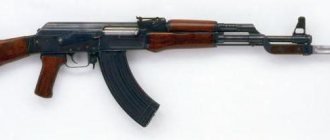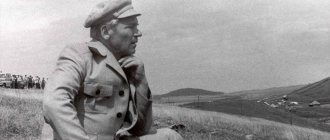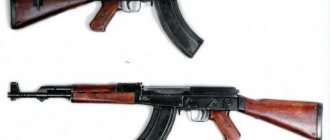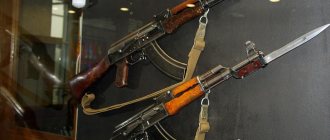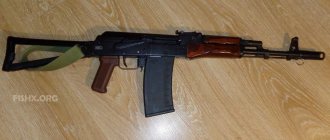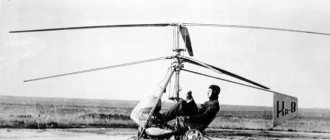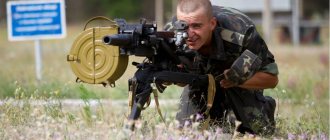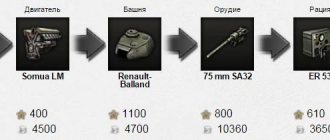When was the first Kalashnikov assault rifle created?
Already during the Great Patriotic War, it was clear to military analysts that all the weapons in service with the Soviet Army were significantly outdated, although they were not inferior to analogues from enemies or allies. But still, the Mosin rifle, SVT, PPSh, PPS and other models had significant shortcomings, which were impossible to eradicate through simple modernization.
The army needed a fundamentally new weapon. Not as powerful as the “three-line”, characterized by a low rate of fire and the use of an expensive cartridge. But at the same time, it was more powerful than the submachine guns in service, which, despite their high rate of fire, did not have high penetration power or significant combat range.
Our designers were prompted to create new models by captured samples, namely the experimental MKb.42(H), which had just entered the German troops for testing - in the future it would turn into the rather famous Sturmgewehr 44 (StG-44).
German geniuses have already come to what designers in the rest of the world will only realize a few years later - soldiers need an intermediate cartridge, which is a compromise between rifle and pistol ammunition. As a result, 7.92x33 mm was created, for which the machine gun was developed.
In fact, the first machine gun was created back in the Russian Empire in 1916 by Vladimir Fedorov and he used a Japanese rifle cartridge 6.5x50 mm, which can hardly be called intermediate.
Inspired by a rather successful model, the designers began to create more suitable ammunition. As a result, the 7.62x41 mm cartridge was born, which was soon modified to become the widely known 7.62x39 mm.
Having assessed the merits of a completely new ammunition, the People's Commissariat of Defense of the USSR immediately announced a competition to create weapons using it. Moreover, it was decided to develop not just one sample, but a whole complex. Namely: a self-loading carbine, a light machine gun and an assault rifle. As a result, the Simonov self-loading carbine, the Degtyarev light machine gun and, of course, the Kalashnikov assault rifle were born, which could be used perfectly together, effectively compensating for each other’s shortcomings and providing maximum versatility to combat units.
But let's focus specifically on AK.
At the 1943 competition, the machine gun of the still unknown, young designer Mikhail Timofeevich Kalashnikov won. By the way, before this he had already developed two submachine guns chambered for the TT cartridge, but they were inferior in a number of parameters to the already existing PPSh and PPS, so they were not adopted for service.
But the machine gun turned out to be very successful. It amazingly combined reliability, ease of use, high rate of fire, serious combat range and good penetration ability. Of course, there were some modifications - initially only a few machines were produced, which were subjected to a wide variety of tests. As a result, major changes were introduced to the design.
For example, the cocking handle was moved from the left side to the right. And two flags - the fire mode switch and the safety switch - which were initially located separately, were combined into one that combines their functions.
This is how the legendary machine gun appeared.
Who are you, Herr Schmeisser?
The name “Schmeisser” has long become a household name and lives its own separate life, apart from the family clan of famous Zulian gunsmiths. The first person to glorify it in the narrow circle of the weapons world was Louis Schmeisser. He worked for the famous German arms manufacturer Bergmann at (Bergmann's Industriewerke Gaggenau), where he developed several early self-loading pistols, as well as machine guns, produced under the name of the factory owner.
However, Louis's main work, so to speak, was his children - Hugo, Otto and Hans.
In 1905, Schmeisser changed jobs, moving to (Rheinmetall), where he worked until his death, continuing work on self-loading and automatic weapons. He left the design of weapons for Bergman in the care of his eldest son, Hugo, who received the main glory - both well-deserved and not so well-deserved.
Who actually invented the Kalashnikov assault rifle
Today, rumors are quite actively circulating among experts, especially “sofa” ones, that the Kalashnikov assault rifle was not developed by a Russian expert at all - they say, the model was simply copied from the German StG-44.
This rather persistent myth is worth dispelling. In general, it is enough to look at the disassembly diagram to understand that these two machines - Russian and German - despite their external similarity, have completely different structures.
Perhaps one of the main distinguishing features is the completely different way of locking the barrel - for automatic weapons this parameter is one of the most important. Thus, in a Kalashnikov assault rifle, the barrel locks the bolt, which rotates around the longitudinal axis. In the German analogue, the principle is completely different - here the shutter rotates in a vertical plane.
The layout is also different here. For example, on an AK, the trigger mechanism (also known as the trigger) is not removable, and the entire return mechanism is located in the receiver. Therefore, there is no need to remove the stock to disassemble the machine gun. The StG-44 is completely different. Here the recoil spring can only be removed by detaching the stock. At the same time, the trigger is also disconnected - it goes down along with the pistol grip.
There are a number of other, smaller differences, such as the design of the receiver, magazine mounts and others.
Therefore, we can say with confidence that despite the undoubted advantages of the German machine gun, the Soviet analogue not only surpasses it in all respects, but is also a completely independent model.
Interwar years
In 1920, the Schmeisser brothers broke ties with Bergman and contacted another arms company, CG Haenel. This company produced self-loading pistols and air rifles designed by the Schmeisser brothers, and in 1928 released an improved version of the MP.18 submachine gun, which received the MP.28 index.
German soldier armed with PP MP.28, 1943
One of the differences between this model and its predecessor was a new trigger mechanism, designed and patented by Hans, which made it possible to switch fire modes - single shots or bursts.
Soviet engineers, in a report on testing the captured MP.28, described this improvement as follows: “A clear example of how not to design such mechanisms.”
One of the main achievements of Hugo Schmeisser in the twenties was a new box magazine for the MP.18 and - a little later - the MP.28, which had a two-row arrangement of cartridges with a rearrangement at the exit into one row. This was necessary for the MP.18, since it was originally developed for magazines from the Luger pistol. In MP.28, this decision was made for compatibility with magazines from MP.18. But why Vollmer chose such a magazine design, protected by a patent in the name of Hugo Schmeisser, for his ERMA MP.38 submachine guns still remains a question.
MP.18 and MP.28 (photo: Source)
From the point of view of ease of loading and reliability, the double-row magazines previously used by Volmer in the ERMA EMP submachine guns were much better.
First combat use of the AK-47
It is officially believed that the AK was first used in combat during the suppression of the Hungarian uprising that took place in 1956. However, this is only the case if we consider its use by Soviet troops who helped suppress the uprising of the army of a friendly country.
In fact, by 1956, a fierce war was already being waged thousands of kilometers from Hungary, where the AK found much wider use. Of course, the conversation is about Vietnam. During these years, the country received significant military assistance from the USSR. In addition to modern aircraft, anti-aircraft missile systems and other types of weapons, Vietnam received a large number of Kalashnikov assault rifles.
And they performed well in this conflict. High humidity, dirt, the inability to regularly clean weapons, and the low level of training of soldiers - all this posed a serious challenge to the machine gun created by the Russian genius. And he passed all these tests, once again proving his incredible survivability and unpretentiousness.
Moreover, there are many eyewitness accounts that even American soldiers, including the elite - Marines and Special Forces - willingly exchanged standard M-16s for captured AKs when possible. There is even an opinion that this weapon was considered elite. Despite the undoubted superiority demonstrated by the American machine gun during field tests, in the jungle they showed rather low reliability. Military experts working in the offices recommended cleaning the M-16 at least several times a day. But even so, the weapons regularly jammed, which often led to the death of soldiers. The AK, which the partisans had not cleaned for weeks, had no such problems and always performed its function effectively.
Design and principle of operation
In total, the Kalashnikov assault rifle consists of 95 parts. It is pointless to list them all - most of the names will tell about something only to specialists. There are significantly fewer main mechanisms and parts:
- A base consisting of a stock, sights, receiver and barrel.
- The receiver cover is detachable.
- A bolt carrier connected to a gas piston.
- Return mechanism.
- Gate.
- USM.
- Gas tube and barrel lining.
- Handguard.
Mandatory accessories are a bayonet and a magazine. Interestingly, initially the 6X2 bayonet was quite long and at the same time narrow - its main purpose was to defeat the enemy in close combat. Over time he changed. At first, a very short and wide 6X3 was adopted. Not very convenient, it nevertheless turned out to be multifunctional. A special device made it possible to connect it with a scabbard, resulting in powerful cutters with which you can cut through wire barriers. The file on the butt increased efficiency. Subsequently, with the advent of the AK-74, the 6X4 bayonet was adopted - something in between the models described above, but also having a slot for connection to the scabbard.
The magazine is also a distinctive feature of the machine. Due to the pronounced cylindrical shape of the cartridges, it became particularly curved - later versions have a relatively straight magazine.
The operating principle of the machine is simple.
When fired, the powder gases push the bullet out and at the same time enter the gas chamber, which causes the bolt to move backward. In this case, the spent cartridge case is ejected, and the cartridge, fed by a spring from the magazine, rises. When the shutter moves, the return spring contracts - as soon as the gas pressure drops, it immediately unclenches. This leads to the reverse movement of the bolt frame and the cartridge being sent into the barrel. At the same time, the bolt frame acts on the self-timer feather, separating it from the trigger. The latter stands on the front sear. The weapon is ready for the next shot.
Specifications
For all its simplicity, the Kalashnikov assault rifle has very good characteristics. At least in the middle of the last century, not a single sample could compare with it. To better understand the issue, it is worth listing the main characteristics of the weapon:
| Characteristic | Parameter |
| Caliber | 7.62 |
| Barrel length | 415 mm |
| Barrel type | Threaded |
| Ammunition type | 7.62x39 |
| Magazine capacity | 30 rounds |
| Shot speed | 715 m/s |
| Rate of fire | 600 rounds per minute |
| Aim | Open, consists of a rear sight and a front sight |
| Energy source | Powder gases |
| Weight | 4.3 kg without cartridges and bayonet |
Modifications and varieties
It would be strange if such a successful weapon as the Kalashnikov assault rifle did not subsequently undergo numerous modifications and modifications.
- Therefore, in the same 1949, the AKS was also developed - they were put into service at the same time. Its only difference was the butt. Instead of a clumsy wooden one, like an AK, this machine gun received a metal stock that folded down. This decision made it possible to reduce the length of the weapon, so it was put into service with the airborne troops.
- Ten years later, in 1959, the AKM, a modernized Kalashnikov assault rifle, was adopted for service, designed to completely replace the outdated version. One of the most noticeable differences was the appearance of a muzzle compensator - an oblique cut at the end of the barrel, which reduced the toss of the weapon when firing and, accordingly, increased accuracy. A new bayonet-knife also appeared, as mentioned above. The receiver for the AKM was stamped, which had a positive effect on its weight. Finally, the stock was raised slightly, making the weapon more comfortable to use.
- Three years later, the AKMS appeared - an assault rifle for paratroopers. In essence, it was the same AKM, but with a metal folding butt.
- A serious modification was made already in 1974. Then a completely new machine gun was developed, using a 5.45x39 mm cartridge. Lighter (1 kg lighter than the AK), it provided the bullet with a higher initial velocity (900 m/s versus 710), due to which the sighting range increased from 800 meters to 1000. In addition, the cartridge weighed significantly less - 10 grams versus 16. Of course, 6 grams is a small thing. But if a soldier had to carry several hundred rounds of ammunition, the difference became very noticeable and was already measured in kilograms. Penetration and flatness have also increased. There were some drawbacks - the stopping effect of the bullet was reduced, and the risk of ricochets when shooting through leaves and branches increased. However, experts felt that the pros outweighed the cons. In addition, the new machine gun received a muzzle brake-compensator, which increased the convenience of shooting.
- At the end of the 70s, another assault rifle was developed - the AKS-74U. Its barrel is much shorter - 206 mm versus 415 in previous versions. And the frame folding stock made it possible to shorten the weapon to 490 mm. Of course, this affected the combat range - the sighting range was reduced to 500 meters. But this turned out to be quite enough for conducting military operations in the city.
- For a long time, the AK-74 was in service with the USSR. And then the collapse of the state struck and there was no time for modifications of weapons - to preserve the existing samples.
- Therefore, only by the end of the nineties, new assault rifles - the so-called hundredth series: AK-101, AK-102, AK-103, AK-104 and AK-105 - entered service. The first two were intended for export and used the NATO 5.56 mm cartridge - they differed in barrel length.
- AK-103 and AK-104 used the classic cartridge - 7.62x39. The difference between them was the same barrel length.
- Finally, the AK-105 was designed for the usual 5.45 mm ammunition.
- Later, the AK-107, AK-108 and AK-109 appeared, similar to each other, but using all three of the above ammunition.
- Finally, in 2022, the AK-12 was put into service, having undergone major changes. The complicated device reduced reliability, but increased ease of use. In addition, the machine gun received a camouflage “digital” color instead of the classic black and brown colors. One of the main differences was the presence of an additional firing mode - with a cut-off of 2 rounds.
Separately, it is worth mentioning about hunting weapons. In the 70s, Saiga rifled hunting carbines were created on the basis of the AK. Subsequently, a modification of the 5.45 mm caliber appeared. Later, smooth-bore semi-automatic carbines were released, also created on the basis of the Kalashnikov assault rifle. They are presented in three calibers: 12, 20 and 410. Smooth-bore and rifled weapons have gained wide popularity and are in demand all over the world. Moreover, the owners include not only hunters, collectors and shooting enthusiasts, but also intelligence operatives.
Our days
AK-200 - the latest development from Kalashnikovs / Photo: pbs.twimg.com
Over the history of its existence, the machine has undergone numerous modifications and improvements, but at every stage it has maintained a leading position in quality. After the AK-47, the AK-74 appeared, designed for Soviet low-pulse cartridges.
In 1979, the compact AKSU assault rifle was created, popular during the Afghan War. After the collapse of the USSR, the “hundredth” series of assault rifles appeared, which had no end to foreign customers. Among the latest developments are the “200th” Kalash and machine guns adapted for NATO caliber cartridges.
Production and use of AKs outside Russia
Experts around the world quickly appreciated the numerous advantages of the Kalashnikov assault rifle. As a result, already in the early 50s of the 20th century, the license for its production was purchased by 18 countries - mainly participants in the Warsaw Pact. Around the same time, machine gun production began without a license in 12 other countries. Well, in how many countries AKs are produced using the artisanal method, it is generally impossible to say.
Some manufacturers simply copied a reliable, proven and quite convenient machine gun. Others subjected the models to certain modifications - in most cases quite minor, rather cosmetic.
For example, in Romania, Yugoslavia and some other countries of Eastern Europe, samples were produced equipped with an additional pistol grip. It was located under the fore-end and made it easier to hold the weapon when firing in bursts. In addition, the following changes were made: bayonet mounts, finishing, butt and fore-end materials.
In addition, the GDR launched the production of AKs chambered for a very non-standard cartridge for assault rifles - .22LR, which was a training cartridge. All over the world, including the USSR, carbines, sniper rifles and machine guns were created based on this legendary weapon.
Sometimes very complex and intricate chains took place, which led to the creation of completely unusual weapons. For example, the Finnish Valmet Rk 62 assault rifle was a licensed copy of Russian weapons. On its basis, the Israeli Galil was created. It has already been redesigned in South Africa, creating the Vektor R4. Finally, this sample was modified in the same South Africa, resulting in the Vektor CR-21 bullpup. So, despite their dissimilarity, the AK and Vektor CR-21 are fairly close relatives.
Well, it is simply impossible to list all the conflicts that have taken place on Earth over the past 70 years where the AK was used. It would be more correct to assume that such conflicts where it was not used simply did not exist.
About 100 million copies were officially produced alone, that is, one for every 70 people. No other type of weapon can boast of such popularity.
The AK was or is in service in more than fifty countries around the world, not to mention partisan, terrorist and insurgent movements. The reasons for its popularity remain the same - ease of manufacture (hence the low cost and reliability, of course, when using high-quality materials and adherence to technology) and ease of use - the entire course of mastering the handling skill is only 10 hours.
The Schmeisser case is still alive today
The Schmeisser family name remains not only in legends. In one of the former Soviet republics, back in the 1990s, they created a joint venture with the German company ERMA and for some reason named it in honor of Hugo Schmeisser. It still exists today. The main products of the company were traumatic and gas pistols.
“Schmeisser” weapons are also produced in Germany - where the rights to the trademark belong to the company Waffen Schumacher GmbH, which produces “truly Aryan” samples under this name - for example, clones of American AR-15 rifles and M1911 pistols.
So the legend of Schmeisser lives on to this day.
